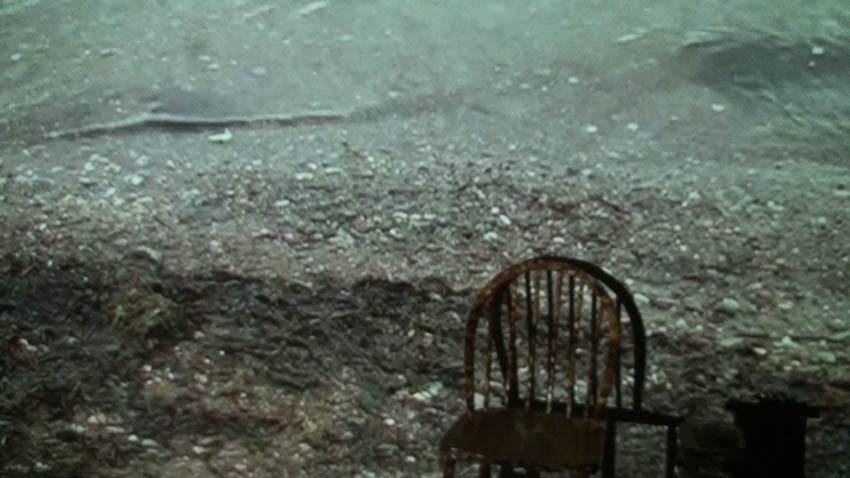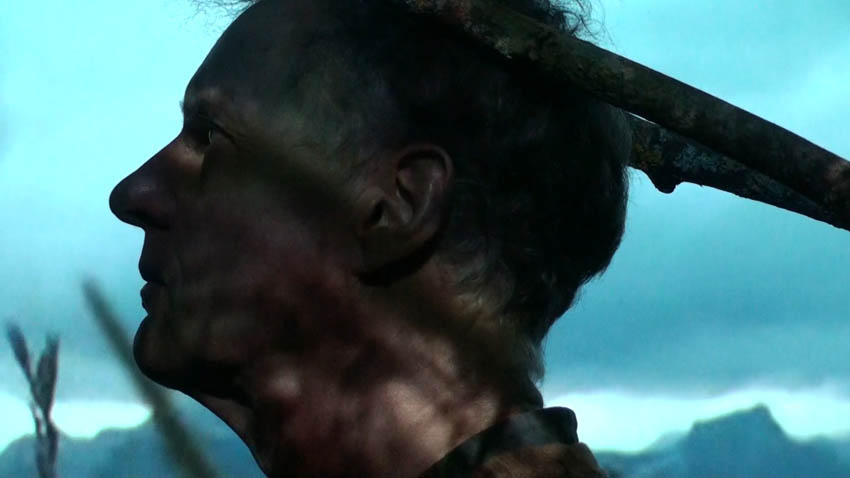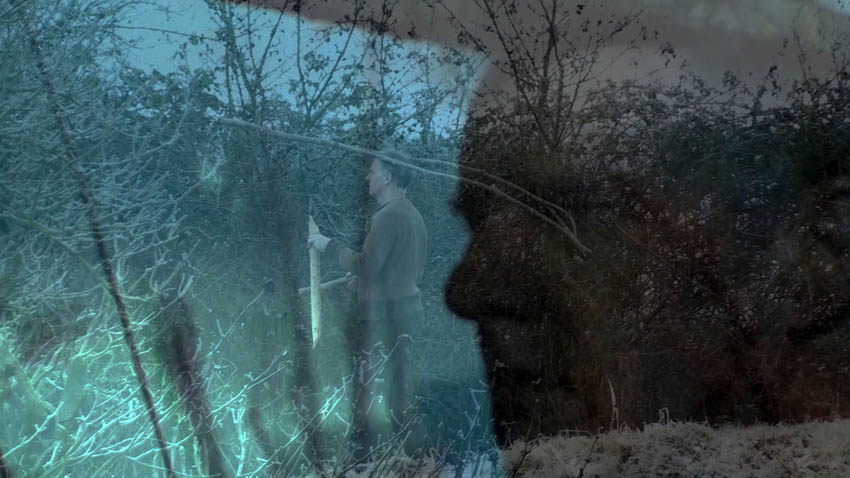Journeying
I hesitate as I start writing, conscious of the limits of the possible.
But I start anyway.
When do I start a journey?
Where do I start a journal?
I’ve just coined the word, a journeying, for something that is a part of my activity. Like a journal and like a journey, but it's not chronological. It's no more or less than a series of notes and thoughts with no defined theme but with lots of connections and maybe some spontaneous coherence. Often it's connected with making new work, thinking about where I've come from and where I'm going. Trying to merge my inner world with my actions to intensify both. It starts and stops, reverses, loops around itself, looking inside as well as out, expands, contracts, inverts, intensifies, disperses, flies, swims, ducks and dives, but always pauses to reflect too, to examine itself. It doesn't recognise time passing. Present, past and future fuse together. That's what I mean by journeying. That's why I make it a noun and a verb at the same time. A journey always journeying but never journeyed. A state of being. Life lived.

One
start is at a waterfall on the first day of the new millenium with a
group of friends. We make sounds with water, slate and pottery. The
sounds are melodic. Each slate is tuned to a different note and, as
water falls onto it, it activates the resonance of the pottery tube
below. A few days earlier the waterfall had been gently dripping and
encouraged quiet contemplation. But there has been heavy rain and the
drips have become a torrent. I listen hard, but the waterfall is loud.
It masks the melodies but it enhances the gesture of interacting with
elemental forces, making it seem more ritualistic. This pleases me.
It helps me imagine. I imagine our sounds being carried by the stream,
the Cozanne into the river Saône, joining the Rhône at Lyon,
growing bigger and stronger as they are swept by the flow down to the
Mediterranean Sea. I try too to imagine the sound flowing through the
Mediterranean to the Atlantic Ocean, and then to all the oceans of the
world. But the idea, although attractive, is far-fetched and seems a
bit barmy. Somewhere between Ibiza and Mallorca, my imagination fails
me! I pass back to my own journey.
One or many?
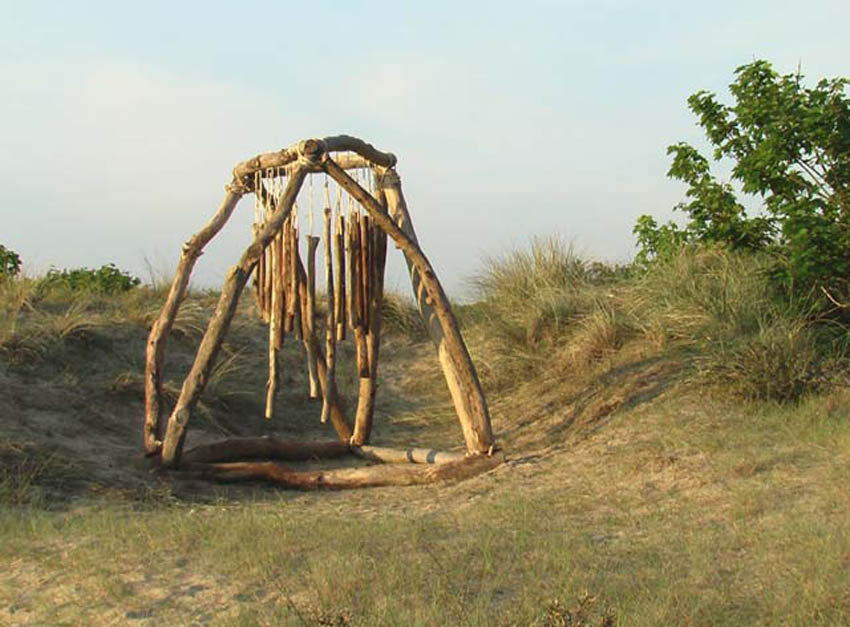
I make a sound sculpture from dead elm branches on the dunes at Ecault
on the English Channel. I call it The Cradle. It seems like
two hands cradling and so protecting the fragile pieces of wood suspended
inside, enabling them to respond to the wind and invent unimagined melodies.
Again, I think of their sounds traveling across the ocean but I am busy
with other work so I soon forget them. Some weeks later, by a happy
coincidence I have the opportunity to create a similar sculpture the
other side of the ocean at Carleton-sur-Mer in Gaspésie, Québec.
It helps to reinforce my imagination of sound traveling across the world;
fading of course to a level that the human ear canít perceive, but never
disappearing completely.
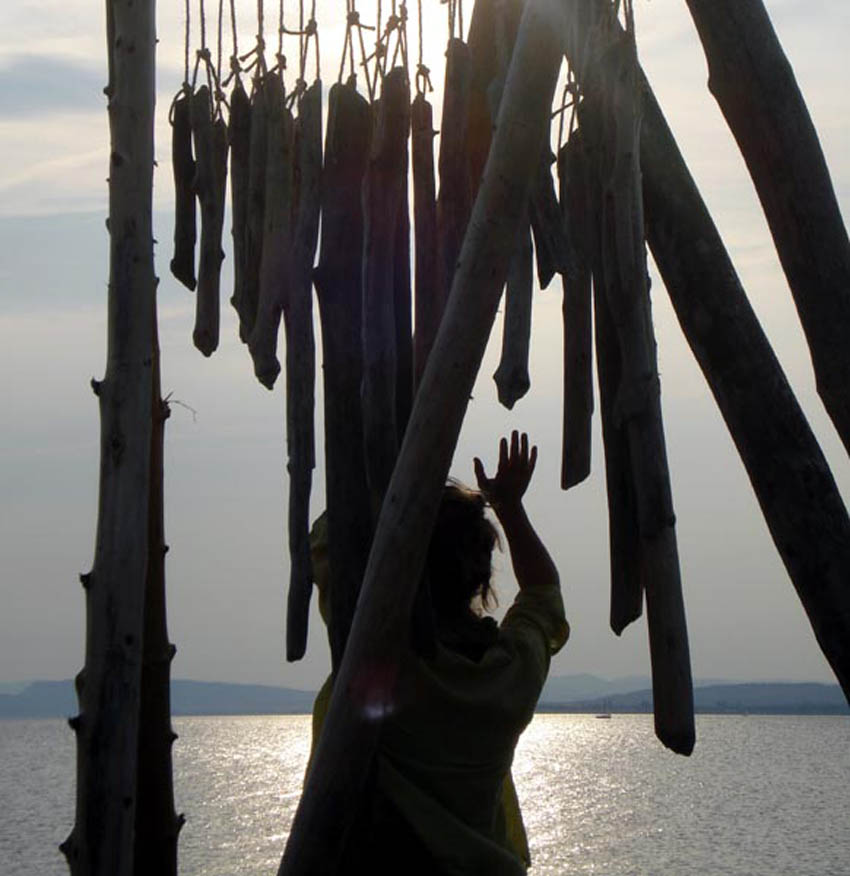
Sometimes my dreaming makes it difficult to separate the sounds that
exist in the outside world, from those that exist in my interior world.
Sounds that I imagine, or sounds that I remember, or sounds that I actually
hear, because they are present inside me, part of my being.
Which
journeys will come together?
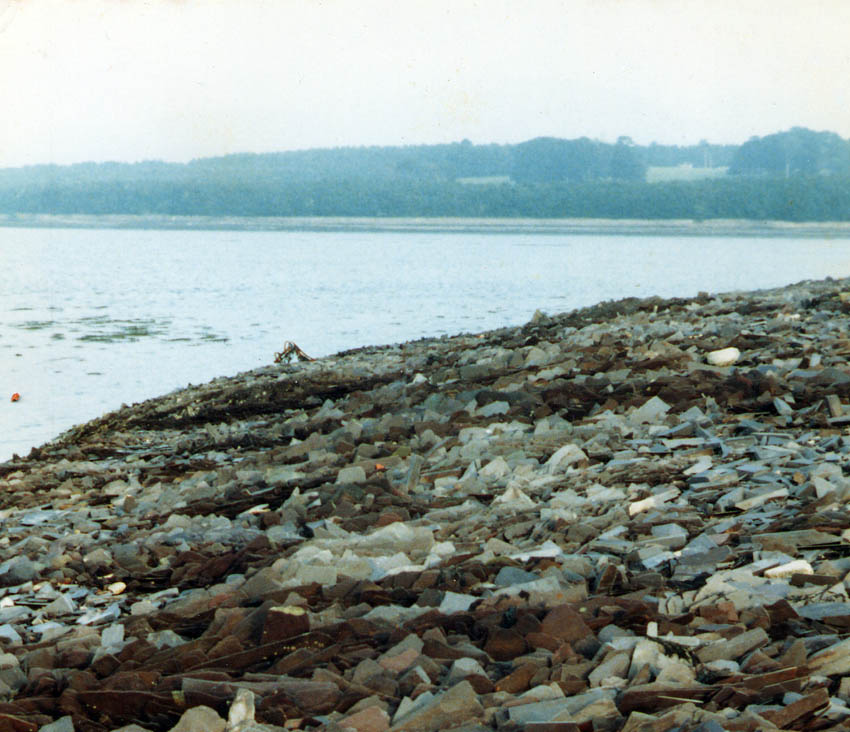
Another start of my journeying is on a beach in north Wales. The beach
is covered with small pieces of slate worn smooth by the action of the
sea. I enjoy the sound of my feet walking on these slate pebbles, then
I take a few in my hands and toss them in to the air. They land nearby,
but far enough to separate them from me so that I can hear their tones
arriving from different directions. The simplest of musical instruments.
I collect a few and take them with me to use later in my journey. I
use a few for a sculpture I make called Le Slow, but then there
is a pause of several years before I have the idea of attaching a string
to some of these small slates and dragging them across hard surfaces.
First a concrete floor in a factory in Chalon-sur-Saône where
I am making a performance. Then a street in Dijon, then a snowy mountain
path in the High Atlas, then closer to home again on a rocky riverside
in the Ardèche. Most of the physical traces I leave are invisible.
A few tiny grains scraped off the slate by friction. But sometimes a
string breaks and I leave the slate where it is, far from its natural
habitat, perhaps surrounded by limestone or granite, or even concrete.
Later, when I work with Aurore, a dancer, she takes the same objects
and explores them as pendulums, one slate-on-a-string swings from the
hand of each of the students that we are working with. Sound becomes
secondary as gravity and body form are explored.
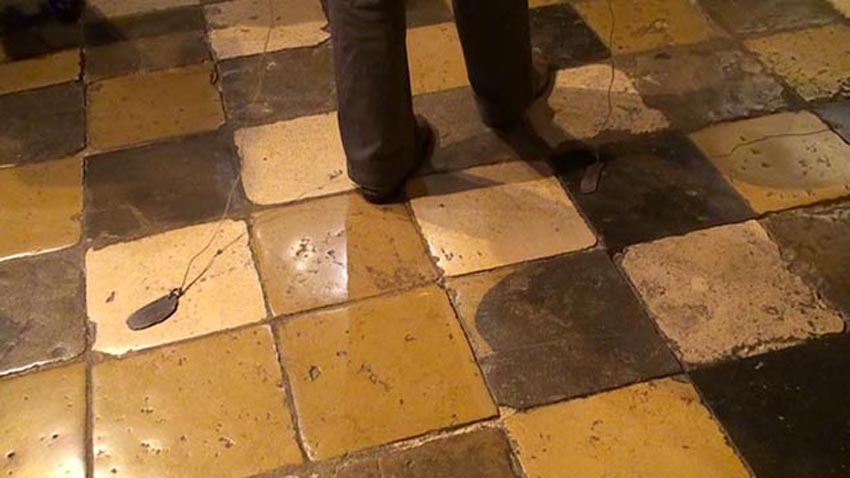
Yet my journey had previously explored the gravity of much longer pendulums
as a sound making device. I make the first one in my workshop which
has a pitched ceiling rising to 5 metres in the centre. A useful height
for a pendulum and I later decide it is the minimum to make a good one.
Whenever I worked in a room at least five metres high with a good structure
to hang a wire from I would hang a 20kg block of slate and let it drag
a small slate or stick over objects laid on the floor. Sticks, or stones
or flat roofing slates. Once I extended the height to 10 metres in a
church that had become a performance space. Then amazingly, a space 30
metres high that had been a steelworks and is now an industrial museum, in Rotherham in the north of England.
At this height the pendulum slows down to a periodic swing of 15 seconds,
something that like the waterfall I mentioned earlier invites a ritualistic
interpretation, and the slow motion effect takes my imagination into
a different world. An extraordinary memory comes back. I have already
been in this place with my father 45 years earlier when it was still
a working steel works and my father worked as a research scientist for
the parent company. I remember the heat radiating from the furnaces
as they are emptied and my fear at being so close to molten metal. Could
this have been another start to my journeying without me realising it?

Then the slate journey is echoed in wood. If I can tie a string to a
piece of slate, why not do the same for a piece of wood. Take it on
a journey through a park in Paris, or pull it down a museum staircase,
step-by-stepÖ
Through all this my interior journey continues and as time passes the balance between memory and imagination changes. Sometimes I have to even pause before I am sure if I am remembering something that actually happened a long time ago or if I am remembering something that I imagined a long time ago. And then I wonder if that matters. Is it important to separate my imaginary world from the real world or can I simply sense the whole and embrace it as part of my being? And if my memories are so rich must I also continue imagining the future? But maybe that reminds you of something. Maybe Iíve already written a paragraph like thisÖ Of course I continue. Remembering doing is rich, as is remembering imagining. But I donít want to reach a place where I am also remembering not imaginingÖ
More
processes are echoed. As my mind fills with memories of dripping water,
scraping slate and tapping wood and their integration with the sounds
of nature these irregular and ever-changing rhythms gradually seem more
interesting than music. So I follow them where they lead me. It may
seem like a solitary journey, but it isnít. The idea is not to separate
myself from humanity but to share my experiences and feelings. If I
can happily spend half an hour listening to six or seven drips going
in and out of phase with each other, why not echo this process in a
human way and with a material that I know well? So I make a group piece
from tapping logs together. But first I try it out on my own. I record
myself sixteen times, each time tapping a simple drip-like beat with
two logs. Then I make a mix in the studio and listen hard. Sixteen,
I decide quickly, is too many. You hear the richness of each sound and
the subtlety of the resultant rhythms much better if there are rarely
more than five playing at the same time. This experience informs me
when I have the opportunity to present this piece to several different
groups I work with. Each of us taps two bits of wood in the steady beat
of a drip of water from a tree, or a gutter, or a leaky tap (thatís
how I explain it to the group). We listen to each other, not so as to
play together but to avoid each other - to make sure that we are not
playing at the same tempo as someone else in the group. To give the
illusion of there being no human intention behind the sounds.
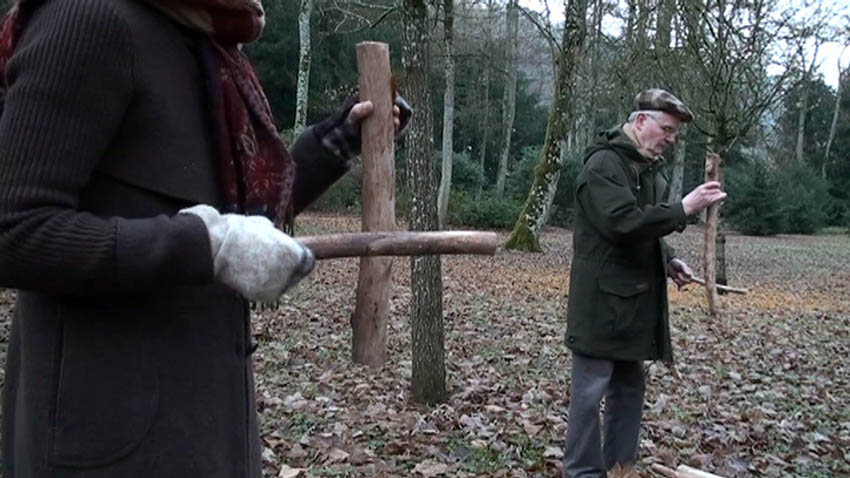
But perhaps the sound we make is still too regular. In fact the sound
each person makes is totally regular. It is expressive because we tap
the sticks sensitively, but it is the relation between our sounds that
is surprising, that would be difficult to notate exactly. How can I
make the individual elements more random ?
For
how long can a part of my journey pause and still come to life again?
How often can I revisit the same place and make fresh explorations?
Leaving
the log imitations of drips aside I go back to real drips with water,
something I have explored often over the years. Iíve made several pieces
with electric pumps and a network of tubes and nozzles that drip water
on to slate. Even though the pumps are unobtrusive they are mechanical
and technological and make repetitive rhythms. How else can I make my
drips? I decide to work with ice. I suspend several small blocks over
each of ten pieces of slate. The sound is much less predictable. Sometimes
notes repeat, sometimes there are quite long silences; only occasionally
is there a hint of a regular rhythm. The piece, coloured by the speed
at which the ice blocks melt, responds to the conditions, especially
the temperature and, if outside, also to the wind and rain. This gives
it a finite life. Below zero it hibernates. At 4 degrees it is almost
silent. At 10 degrees with a light wind the drips last for 3 or 4 hours.
At 15 degrees inside they last 8 hours.
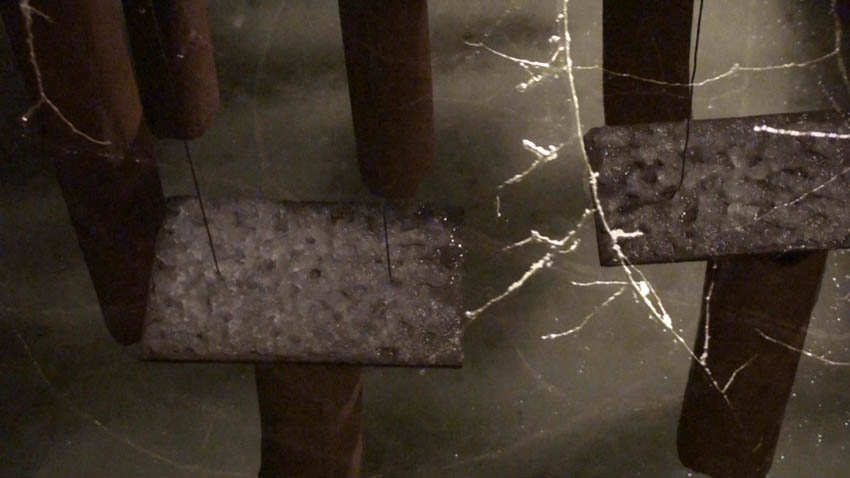
Another part of my interior journey takes me away from my hands and
my breath. As a musician I am formed by what my hands can do in manipulating
sound. More specifically as a saxophone player my sense of phrasing
comes from the rhythm of my breathing and the capacity of my lungs.
This thought, many years ago, led me to name one of my compositions
Wind and Fingers, the two elements that I saw as the practical
tools of music making. But now I wonder if this musical tradition is
too much of a constraint on the sound I make. How human do I want my
sounds to be? Recently I have often talked about the desire to let my
sound sculptures be themselves, to make their own music without human
intervention. I have wanted to encourage a way of listening that is
closer to how we listen to nature. Also, over the last ten years I have
often worked with dancers and been inspired by their physical relationship
with my sculptures, so different from that of a musician. By osmosis
I have gradually taken on both of these factors in how I relate to my
sculptures in performance.
Most recently, in fact only a week ago as I write this, I performed a new solo piece called Dark and Light Matter. I based it around three of my sound sculptures. My aim then was to let the sculptures be themselves and also to relate to them closely with my whole body, not just my wind and fingers. So I walk very close to Air Sur Terre letting my shoulder just brush against it. I push my way into Standing Steel, enjoying the clatter of the steel bars and then letting the sound subside into a gentle murmur that sounds like voices echoing in a long tunnel, and lasts much longer than I expect. The bars themselves are solid, not hollow, but I imagine the vibrations inside them rushing back and forth from one end to the other, not able to escape and only gradually able to transfer their vibrations to the air.
Then
my journeying makes me wonder what it would be like if I separate my
body more from the sculptures. I place a forked branch on my head, projecting
a metre in front and about the same behind. It constrains my movements.
I must keep my head up and my back straight or it will fall off. I must
not make any sudden movements. I can move fast if I am careful but I
must accelerate slowly. I imagine a stag moving through a forest, its
personal space delineated in part by its antlers. But of course itís
not the same. The antlers are part of the stagís being in a way that
this branch isnít of mine - or not yet anyway - I then think of the
way a backpack can become part of me if I carry it for many days. I
measure my new ďbody plus branch on headĒ against three of my sculptures.
I can turn around close to Air Sur Terre letting the front
of the branch just pass over the top of the sculpture. But I must carefully
bend my head forward if I am to raise the forked end of the branch behind
me enough for it to clear the sculpture.
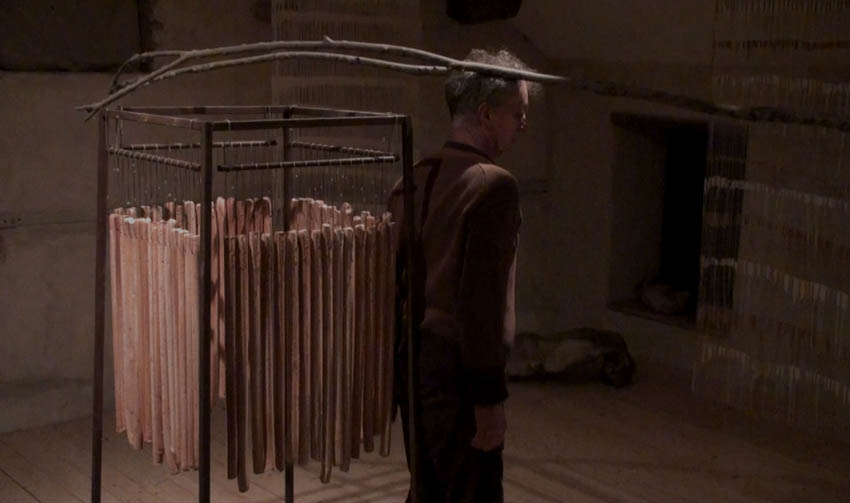
Near Standing Steel I can push each hanging bar individually
with the branch. I can pass the branch between two of the bars and then
push a bar on the opposite side of the sculpture. I withdraw carefully
so that the branch doesnít hook onto one of the bars and pull itself
off my head.
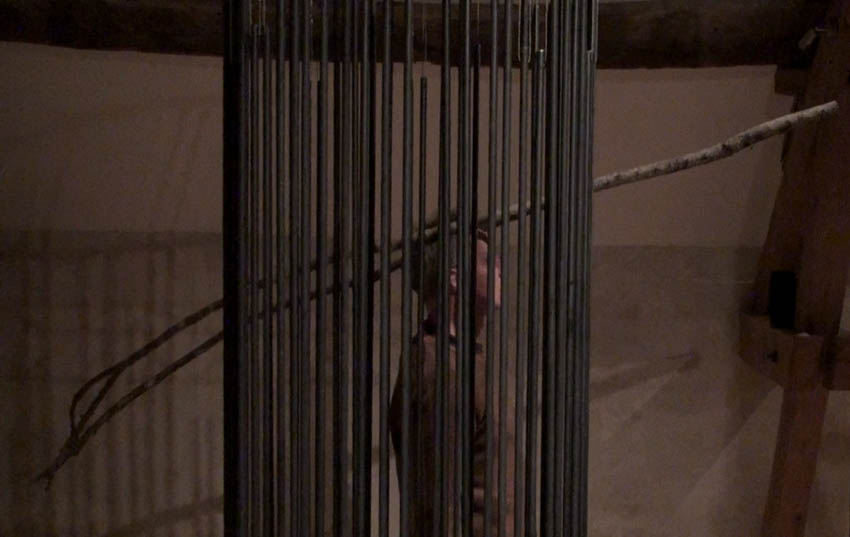
I can also get close to Elm Trio, easily passing my branch
between the three ropes that support the wood. The trunks are heavy
so it is difficult to manipulate them with my branch. But I can lean
against the sculpture enabling my left hand just to reach to its top
and steady myself while I push the trunks against each other with my
knee and my foot.
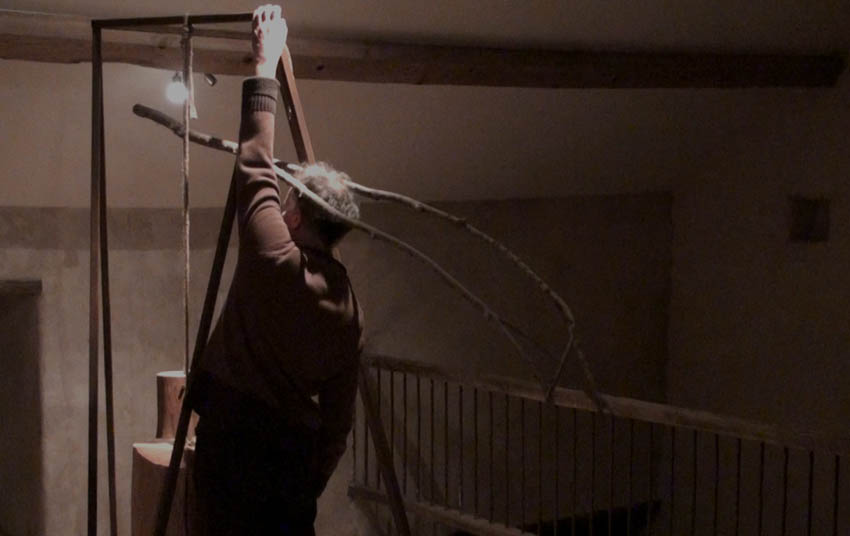
Yet reflecting on all this as I plan and rehearse the performance I
realise that there is also a contradiction present. On the one hand
the process is very physical and direct and therefore accessible, but
on the other hand it has a certain ascetic quality to it that withholds
some of the traditional pleasures of music such as a regular beat and
recognisable melody. By emphasising the primordial and the sensorial
it somehow bypasses thousands of years of cultural history. This of
course is where my journeying has arrived, but maybe it makes it difficult
for some people to enter my world, which is above all what I want. Given
that Iím performing in a room solely with objects that I have created,
and no conventional musical instruments, maybe the link with nature
isnít clear enough. So I decide to broaden the context and start the
evening by projecting a ten minute film, Alpage,
that I made this summer in the Alps. Close-up shots of grasses battered
by a strong wind, mountains in the background and meanwhile, off-screen
but recorded live together with the images, I play mbira in a way that
adds to the natural sounds present. Wind, birds, sheep, marmottesÖ
So in the intensified moment of a performance I try to give a wider, perhaps gentler, impression of my journey, always trying to invite rather than exclude.
Then
my journey takes me to my desk where I write these words, to help me
clarify my thoughts for the next step and
to share them with you.
next : drifting flamingoes and
sonic cranes
états
de matière - dark and light (film)
alpage 28.06.2014 (film)
shoreline (film)
Will Menter, January 2015
writing by will
performances,
installations, music
